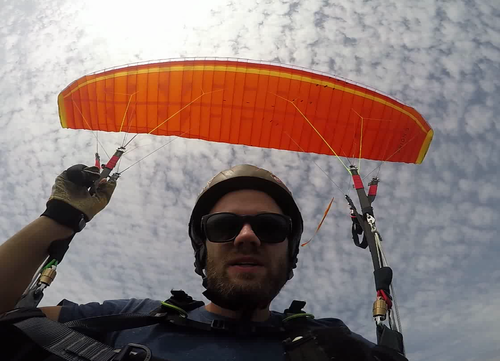NOVA Prion 3 M |
|||||||||||||||||||||||||||||||||||||||||||||||||||||||||||||||||||||||||||||||||||||||||||||||||||||||||||||||||||


|
|||||||||||||||||||||||||||||||||||||||||||||||||||||||||||||||||||||||||||||||||||||||||||||||||||||||||||||||||||
Instability rating |
|||||||||||||||||||||||||||||||||||||||||||||||||||||||||||||||||||||||||||||||||||||||||||||||||||||||||||||||||||
|
|||||||||||||||||||||||||||||||||||||||||||||||||||||||||||||||||||||||||||||||||||||||||||||||||||||||||||||||||||
Glider characteristics |
|||||||||||||||||||||||||||||||||||||||||||||||||||||||||||||||||||||||||||||||||||||||||||||||||||||||||||||||||||
|
Launch preparations: easy
launch characteristics: balanced, climbs constantly, no guidance necessary, good feedback during inflation, moderate braking required, slows before zenith, control check simple, low takeoff speed
asymmetric collapse: canopy colllapses at high angle to leading edge, moderate dynamics, total course change 180-270°, (3), moderate course change rate, moderate forward pitching 45-60°, (2), moderate height loss 30-39 m, (2), low sink velocity 10-14 m/s, (1), G-Force < 2,5 G, (1)
Frontal collapse: canopy collapses with low total collapse area, moderate pitch backwards 30-45°, low pitch forwards <30°, low dynamics, no course change, (1), recovery usually immediate, symmetric recovery, immediate return to normal airspeed, moderate height loss 30-39 m, (2), very low sink velocity <10 m/s, (1)
Spiral dives: moderate sink velocity increase, Moderate G-Force 3,5- 4.0 G, (2), Sink velocity after 720° <14 m/s, (1), Moderate maximum sink velocity < 18 m/s, (2), sink velocity increase < 3 m/s on brake release, (1), Course change 90-180° after spiral exit, (1), moderate height loss during recovery 30-60 m, (2)
B-Stall: high force required, high pitch backwards 45-60°, moderate pitch forwards 15-30°, stable sink phase, low deformation tendency, immediate return to normal airspeed, 6-8 m/s, height loss on recovery 20-40 m
big ears: simple initiation, stable flight phase, immediate automatic recovery, Vsink unaccelerated < 2,5 m/s, Vsink accelerated 3-3,5 m/s, Vunaccelerated 3-5 km/h less than trimspeed, Vaccelerated 0-3 km/h faster than trimspeed
Steering behaviour: balanced, 75 cm brake travel range, very noticable brake pressure increasse, normal stall point, easily identifiable |
|||||||||||||||||||||||||||||||||||||||||||||||||||||||||||||||||||||||||||||||||||||||||||||||||||||||||||||||||||
Notes |
|||||||||||||||||||||||||||||||||||||||||||||||||||||||||||||||||||||||||||||||||||||||||||||||||||||||||||||||||||
|
TakeOff The glider is easy to prepare. The lines and risers are easy to check. The Lines have the recommended colours of the PMA. Left and right riser are marked with the colours red and green. After the impuls of the pilot, the glider climbs nice and without any additional pilotsupport. The glider slows down by it self above the pilot but needs some brake. Air Glider shows a nice handling. Even that the canopy shows a soft feeling, the glider is very stable and calm. Asymmetric Collapse The pitch forward of the canopy is always around 60° and thus close to the next higher Safety Class 4. If the deformation is a little bit bigger than the maximum of the measuring field, the glider shows a stronger pitch with even more than 70°. If the collapse is not very surface deep, the glider just turns up to 90°. If they are bigger, the glider can turn up to 180°. The maximum sinkrate is quite low. Front Collapse It was not possible to do very big collapses. The behavior can be different to the results of the safetyclass if the collapses are bigger. Spiral Very easy and controlable. Exit is very fast after the release of the brakes. Longest turn after brakerelease were 180° B-Line-Stall Clear pitch during entry and medium pitch in exit. Glider is getting nervous if the b-lines are pulled to the maximum. BigEars Easy |
|||||||||||||||||||||||||||||||||||||||||||||||||||||||||||||||||||||||||||||||||||||||||||||||||||||||||||||||||||
Rating |
|||||||||||||||||||||||||||||||||||||||||||||||||||||||||||||||||||||||||||||||||||||||||||||||||||||||||||||||||||
|
Safety class 3 This class of paraglider react moderately to one or more of the following manoeuvres: frontal collapse, asymmetric collapse or spiral dive.Moderately means that the above manoeuvres result in dynamic reactions from the glider and/or large height losses. Good piloting skills which need to be regularly practised, together with good personal reaction times which are above basic training levels are required to safely fly this class of gliders. Skill and experience levels greater than those attained in basic training are required to safely recover from the above manoeuvres. Emergency descent manoeuvres, in particular spiral dives may require advanced recovery skills. Additional training such as regular ground handling or SIV training is recommended. |
|||||||||||||||||||||||||||||||||||||||||||||||||||||||||||||||||||||||||||||||||||||||||||||||||||||||||||||||||||

